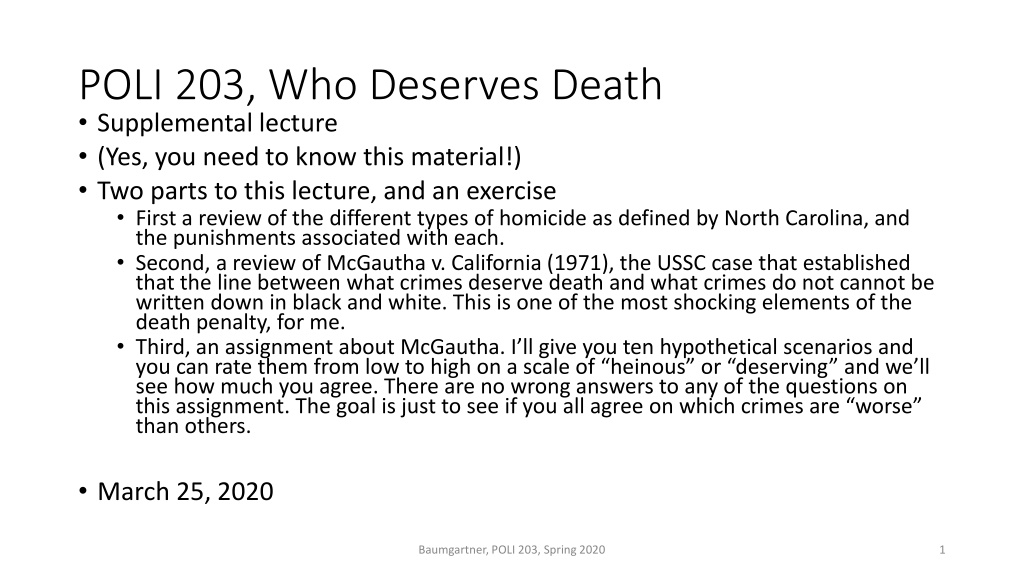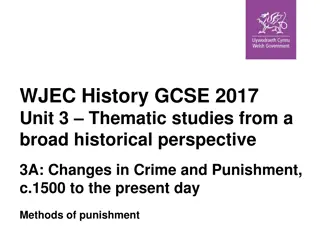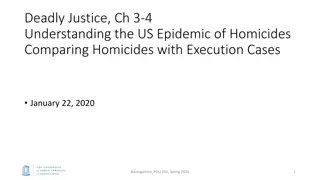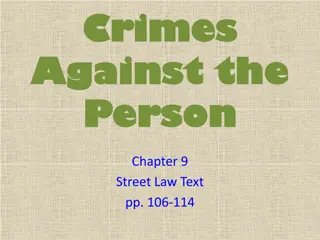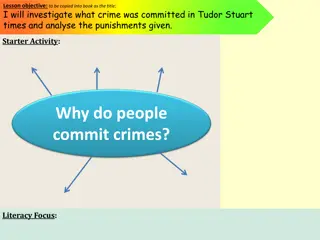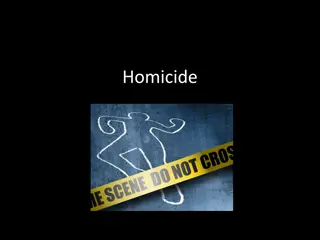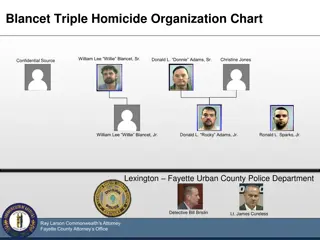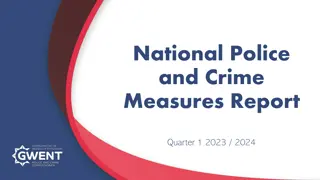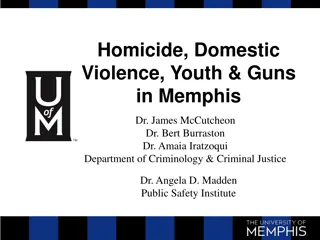Understanding Types of Homicide and Punishments in North Carolina
Explore different types of homicide as defined by North Carolina, along with the associated punishments. Dive into the complexities of determining crimes deserving death penalty, as seen in McGautha v. California (1971), and participate in exercises to gauge perspectives on heinous crimes. Learn about North Carolina Sentencing Guidelines and the range of punishments for various classes of crimes.
Download Presentation

Please find below an Image/Link to download the presentation.
The content on the website is provided AS IS for your information and personal use only. It may not be sold, licensed, or shared on other websites without obtaining consent from the author. Download presentation by click this link. If you encounter any issues during the download, it is possible that the publisher has removed the file from their server.
E N D
Presentation Transcript
POLI 203, Who Deserves Death Supplemental lecture (Yes, you need to know this material!) Two parts to this lecture, and an exercise First a review of the different types of homicide as defined by North Carolina, and the punishments associated with each. Second, a review of McGautha v. California (1971), the USSC case that established that the line between what crimes deserve death and what crimes do not cannot be written down in black and white. This is one of the most shocking elements of the death penalty, for me. Third, an assignment about McGautha. I ll give you ten hypothetical scenarios and you can rate them from low to high on a scale of heinous or deserving and we ll see how much you agree. There are no wrong answers to any of the questions on this assignment. The goal is just to see if you all agree on which crimes are worse than others. March 25, 2020 Baumgartner, POLI 203, Spring 2020 1
What crimes deserve what punishment? McGautha v. California (1971): can we write down on paper the conditions that merit a death sentence as compared to those that deserve a lesser punishment? US Supreme Court: No, that s impossible. We ll talk about this and do an exercise about it. More generally, there are many different levels of punishment for different types of homicide. Let s review that first, using the NC General Statutes as a guide. Baumgartner, POLI 203, Spring 2020 2
NC: Types of homicide All NC laws: https://www.ncga.state.nc.us/gascripts/Statutes/StatutesTOC.pl Homicide, section 14.17 https://www.ncga.state.nc.us/EnactedLegislation/Statutes/HTML/ByA rticle/Chapter_14/Article_6.html Vehicle code, Chapter 20: For deaths, see section 20-141.4. Criminal code, Chapter 14 Criminal procedure, Chapter 15 Baumgartner, POLI 203, Spring 2020 3
North Carolina Sentencing Guidelines List of all felonies in NC, which puts every crime into a Class : http://www.nccourts.org/Courts/CRS/Councils/spac/Sentencing/Training/ Offense.asp. Or see this on the class website: NC-FeloniesByClass.pdf The sentencing grid, showing the range of punishments for each Class of crimes in the list above: http://www.nccourts.org/Courts/CRS/Councils/spac/Sentencing/Punishme nt.asp. Or see this on the class website: NC-FelonyPunishmentsByClass.pdf Example: Class A felonies have a punishment of Death or LWOP Class B1: no less than 144 months (12 years), most likely 192 months (16 years), but potentially up to LWOP, depending on prior points Baumgartner, POLI 203, Spring 2020 4
So, various punishments for different types of homicide: Crime Offense Class Minimum (no prior record, in months) Years First degree murder Second degree murder (unlawful killing with depraved heart malice ) A B1, B2 LWOP 192; 125 LWOP 16, 10 Felony and misdemeanor death by vehicle, impaired boating, etc. B2 125 10 Assault with intent to kill, inflicting serious injury, death by distribution of certain controlled circumstances (e.g., selling drugs) Voluntary manslaughter C 58 4 D 51 4 Assault with intent to kill Involuntary manslaughter E F 20 13 2 1 Baumgartner, POLI 203, Spring 2020 5
You all know Serena Williams Watch this clip of her losing 1-6, 0-6 to Johanna Konta (who??). https://www.espn.com/tennis/story/_/id/24395862/serena-williams-reveals- learned-parole-sister-killer-just-match Her half-sister, Yetunda Price, was killed in a drive-by shooting in 2003. The killers intended to shoot the driver, Yetunda s boyfriend, but missed an killer her instead; she was in the passenger s seat. Because they had not intended to kill her, it was manslaughter, not murder. If the killer had killed the intended victim, it would have been first or second-degree, depending on if it was premeditated. The killer was released in March 2018, having served 12 years for the crime. The release came just before Serena s match, so naturally she was upset. How would you feel? Should the punishment be less because an innocent person was killed by mistake? That s what the law says. Baumgartner, POLI 203, Spring 2020 6
Read through the felony list What are the most questionable equivalencies put down there? How would you revise this classification list if you were in charge? How would you vote on a revision if you were a state legislator? Remember, the felony classes are each going to lead to the same type of punishment. So therefore all the crimes with the same class are assumed to be equally serious. Read that carefully and review for yourself. Note that the homicide cases require some assessment of mens rea the state of mind of the killer, or their intention. Baumgartner, POLI 203, Spring 2020 7
A few ideas about all this Just on the homicide cases, the penalties range from none at all (self defense, not a crime at all), to very low (1 year in prison) for involuntary manslaughter, to higher and higher up to LWOP and Death. The distinctions relate to the intention of the killer. How do we know? Compare the homicide cases to the other kinds of crimes, not resulting in death, that are in the same class. Is that right? Consider the power that this gives to the District Attorney. They decide how to charge, and have the authority to negotiate a plea agreement to a lesser charge. Baumgartner, POLI 203, Spring 2020 8
McGautha v. California See chapter 1 of Deadly Justice, pp. 17 ff. Read the ruling itself on the Deadly Justice website: Legal Citations or click here: https://supreme.justia.com/cases/federal/us/402/183/ McGautha complained that the jurors in his case assigned him to death, but had no clear rules to follow. Isn t that inherently capricious, he asked? Shouldn t there be clear rules? USSC to McGautha: No, we don t have to write it down. Juries can exercise mercy based on so many factors we can t expect any clarity. This is beyond human capacity at this time. Result: no clear, bright line distinction between death-worthy crimes and those that are not. Baumgartner, POLI 203, Spring 2020 9
Which of these crimes deserves death? Review each of the following slides. Rate each of them from most deserving (1) to least deserving (10) Take a few minutes and complete the McGautha Quiz. This just asks you to rank each of the 10 cases from least to most deserving. This quiz is available on Sakai. (Note you are not voting for death, just ranking in order of most deserving) Thanks for Prof. Carol Steiker of Harvard Law School for these questions. I ll compile the results and report back to you next week. Baumgartner, POLI 203, Spring 2020 10
A. Foster mother neglect A middle-aged woman with no substantial criminal record completely neglects a 3-year-old child who is placed with her for foster care, for which the foster mother receives a stipend sufficient to care for the child. The foster mother spends the stipend on her opioid addiction rather than the child, and the child slowly starves to death over a period of months. Baumgartner, POLI 203, Spring 2020 11
B. Alcoholic armed robber A 30-year-old alcoholic with a substantial record of theft offenses commits an armed robbery of a liquor store. When the store clerk reaches for the alarm button, the defendant shoots him once in the chest, killing him. Baumgartner, POLI 203, Spring 2020 12
C. Abused wife A woman who has been repeatedly physically abused by her husband (that is, badly beaten up, but not to the point of being in danger of death) hires a hit man, who kills her husband. The defendant to be sentenced is the wife. Baumgartner, POLI 203, Spring 2020 13
D. Sex offender rape in desert A repeat sex offender a 25-year-old of low intelligence (though not intellectually disabled) who was himself sexually abused as a child kidnaps a college-age woman, drives her into the desert, and then rapes her, beats her, and leaves her there. She dies of exposure to the elements when she can t find her way out of the desert before nightfall. Baumgartner, POLI 203, Spring 2020 14
E. Suicide bomber accomplice A suicide bomber detonates a bomb in a public place, killing 5 and injuring 12. Although the bomber himself is killed in the attack, the members of the radicalized religious cell who helped to plan the attack and make the bomb are arrested. They are two men in their late 20s and one 19-year-old, who has no prior record of adult or juvenile offenses. The defendant to be sentenced is the 19-year-old. Baumgartner, POLI 203, Spring 2020 15
F. Father killer A middle-aged man with no criminal record kills his elderly father who is in a permanent vegetative state in order to inherit his father s estate. Baumgartner, POLI 203, Spring 2020 16
G. Intentional killing of fetus A man beats up his pregnant ex-girlfriend with the express intent of killing her unborn child by another man, with whom she is 8-months pregnant. The mother lives, but the fetus dies. Note: this prosecution takes place in a state that designates the intentional killing of a fetus without the mother s consent as first-degree murder. Baumgartner, POLI 203, Spring 2020 17
H. Young car thief kills police officer An 18-year-old car thief is driving a stolen car when he is stopped by the police. When the officer approaches the driver-side window, the defendant shoots him. The defendant has a juvenile record of theft, assault, and weapons possession. Baumgartner, POLI 203, Spring 2020 18
I. Drug addict arson A drug addict burns down the triple-decker home that he inherited from his parents for the fire insurance. Four members of the family that rented the apartment on the third floor die in the fire. The defendant knew that the rental unit was occupied, but it s not clear whether he knew that the renters were home at the time of the arson. Baumgartner, POLI 203, Spring 2020 19
J. Prison race riot A large-scale fight breaks out between warring racial gangs in prison, during which a white supremacist gang member kills a Hispanic gang member. The defendant was serving time for armed robbery at the time of the riot. Baumgartner, POLI 203, Spring 2020 20
